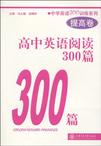高中英语阅读300篇(提高卷)
出版时间:2010-3 出版社:上海交通大学出版社 作者:冯大雄,俞华 主编 页数:325
Tag标签:无
前言
这是一套旧书,从中学英语300训练丛书自第一本《中级英语阅读300篇(高中卷)》初版算起,已有十多个年头了。现在,整套丛书已有近20种书,市场反应热烈,多次重印,总印数超过百万。丛书中有的单本印数已超过了20万册,并有数本书获“全行业优秀畅销书”奖,深受广大中学生读者的欢迎。 这又是一套新书,因为现在呈现在读者面前的,是为2010世博年以后的学生读者重新修订与增补的全新的“300系列”丛书。时代是在发展的,这套丛书当然也必须随着时代的发展而发展,随着教育的发展而变化。这十多年来,教育事业,特别是英语教学有了很大的变化。随着新课标在全国各地的推广,英语教学更加重视基础、重视实用。反映在考试中,是更加强调基础性和实用性。正是在这样的形势下,丛书的编者决定对其实行改版。 首先,是更换了部分较陈旧的题型和题目,更换了某些略嫌过时的内容,而代之以更新鲜的话题和内容。其次,考虑到考试的实际情况,将原先分别出书的语法,词汇及基础知识三册书合而为一,作为《词汇和语法300题》出版。 此外,为了让更多读者结合自身的学习情况有更多的选择,一个很重要的变动是除了听力和写作外,其余各册都推出“基础卷”和“提高卷”。读者可以根据学习的进度和深度,在使用“基础卷”感到学有余力时,选用“提高卷”。 英语学习中最重要、学生花时间最多的、也是考试中分值最多的部分,是阅读。在这方面,再怎样重视都不为过。近年来国家教育部和上海市教委分别编制、并已付诸实践的新《英语课程标准》对英语阅读能力给出了明确的规定,特别是不约而同地对课外阅读量作了具体要求。
内容概要
本书共收集了近300篇短文,分文化教育、新闻报道、科普知识、微型故事、旅游天地、广告通知及最新题型共7个单元。书中文章取材广泛、语言规范、难度适中,能够满足高中学生扩大知识面、提高阅读水平的要求。 本书可供广大高中学生课外阅读;也可作为参加高考复习的学生及指导老师的阅读材料。
书籍目录
文化教育新闻报道科普知识微型故事旅游天地广告通知最新题型练习参考答案
章节摘录
4. We can infer that the writer of this passage wants to tell readers that A. all languages are paradoxes B. languages obey certain regular rules C. you should take the paradoxes in English for granted when you learn it D. it is important to explore the unique lunacy of a language Joy Hirsch, a neuroscientist in New York, has recently foundevidence that children and adults don't use the same parts of the brainwhen learning a second language. He used an instrument called anmri magnetic resonance imaging to study the brains of two groups ofbilingual people.One group consisted of those who had learned asecond language as children. The other consisted of people wholearned their second language later in life. People from both groups were placed inside the MRI scanner. This allowed Hirsch to see which parts of the brain were getting more blood and were more active. He asked people from both groups to think about what they had done the day before, first in one language and then the other. They couldn't speak out loud, because any movement would disrupt the scanning. Hirsch looked specifically at two language centers in the brain——Broca' s area, believed to control speech production, and Wernicke' s area, thought to process meaning. He found that both groups of people used the same part of Wernicke' s area no matter what language they were speaking. But how they used Broca's area was different. People who learned a second language as children used the same region in Broca's area for both languages.People who learned a second language later in life used a special part of Broca's area for their second language——near the one activated for their native tongue.
图书封面
图书标签Tags
无
评论、评分、阅读与下载
用户评论 (总计70条)
- 复习使用,多阅读可以提高英语水平
- 文章比较长,适合高中学有余力的孩子阅读。后有习题。不错
- 对于高考英语阅读的提高有一定的帮助
- 本书很适合基础较好的学生,不错的阅读材料
- 这是一本相当好的英语阅读辅导书!文章有一定的难度,比高考阅读略难,适合进行高考阅读训练,假以时日,阅读定能突破!!
- 看完这些阅读我觉得对英语越来越感兴趣了,老师说:“阅读是提高英语的关键。”我终于体会到了,里面的题目也让我学会了对阅读的思考,非常不错!
- 阅读分类很全,难度适中
- 很好的一本书哦 高中段的同学都很适合 难度较高一些
- 书很好,内容由浅到深 循序渐进,对孩子的英语阅读提高很有帮助。
- 初中买初中三百篇 高中买高中三百篇。。有用
- 初中的时候英语老师一直推荐和一直做的阅读书!很好!
- 不错的一本书,分好几个领域编排,利于学生阅读练习。
- 这本很不错,也不贵,对于提高英语阅读很有帮助哦,推荐
- 能集中的帮妹妹提高英语阅读能力。就是解释再详细些就好了
- 去书店看了实体才在网上买的 感觉里面的内容安排的很合理 长度适中 给高考生考前一个月每天做两篇很好
- 书很不错 有助于提高完型和阅读的准确率
- 书不错 ,我相信有了它我的阅读能力会大有提高的,推荐啊
- 内容挺好的,我是高一的,每天看两篇,对考试的完形填空和阅读理解挺有帮助的
- 系列书籍,从初中到高中,不错。
- 阅读的文章分类明确,只是答案没有提供解析,要想老师询问,增加了老师的负担。
- 不错的一本英语阅读,很喜欢,很赞
- 给儿子的参考书,喜欢上海交大,也喜欢这本书。 有一定难度,对高考有益。
- 适合高二、高三的学生,高一的学生应买基础卷。
- 初中毕业生学习正好!对于词汇的积累与习惯用语来说也是很好的,每天坚持两篇可以使孩子语感提高,物超所值。
- 应该是不错的,尝试做第一篇,感觉很有难度。
- 受益匪浅,有难度。有所提高!
- 每篇阅读,都有几个生单词,但不影响阅读和做题,相信会有帮助。
- 比起学校的变态阅读,这本算简单一点的了。
- 我买是属于提前的,预先复习一下,提高应试成绩
- 认真做很快能提高英语成绩
- 挺适合的,提高英语,每日坚持
- 分类汇编,题量适中。对于拔高来说具有一定效果
- 每天读上一篇,背一背几句美句,成绩很快就能上去了罢。
- 一天两篇足够了
- 建议基础薄弱的人别买.单词难度大
- 商品不错。题目略难,适合高考吧
- 中考前练这本,效果很好。还没做,买了备着,准备高考前练习。
- 很好的复习指导书!
- 很实用,不错,努力学英语。
- 买给孩子的,学校要求买的,必须的
- 书很好 给妹妹买的
- 喜欢这些书。很适合
- 题量特别大,内容新颖又长知识,值得推荐!
- 我买它为了四级 完全是为了找回语感 这本书ok
- 挺不错的一本书,推荐购买喔
- 这本书是给弟弟买的,总体来说还行,如果有答案解析会更好
- 这本书习题挺多的。。而且分类得很好。能抓重点。
- 我为小孩挑选的,他用过后说很好
- 很好很好 买了好久好久了,就是速度慢了点
- 还不错,有用,怕我偷懒写不完。。。。。
- 多做习题,挺好!
- 质量不错,如果有解析的话就更好了~
- 题目内容不错,如果有些详细翻译就更好了
- 好好好好好 好
- 内容很强大!!但是收到的时候上面有一层厚厚的灰
- 帮同学买的~应该不错吧 ~就是是小本的,32开。。。忒小的点,做起来不方便
- 给朋友买的,说是还不错.学习基础的东西.
- 可惜没有答案详解
- 内容比较全,涉及词汇量大,非常实用
- 还没看内容 希望会有所帮助
- 就是没图片上的那么大
- 300篇 难度还不小
- 高考必备的书!
- 一般吧,还行。
- 孩子还没有用呢,外观上不错
- 书是正版的啊 ,快递非常给力
- 适合在90分以上的学生阅读
- 比书店便宜,给儿子买的
- 书中的字太小,阅读困难。
- 阅读学习的好书
推荐图书
- 中外钢材实用技术手册(下)
- 中国国家标准汇编
- 中国国家标准汇编 2008年修订-100
- 中国国家标准汇编 2008年修订-72
- 中国国家标准汇编
- 絵描きのためのチームBLポーズ写真集
- 中国語圏における厨川白村現象
- 阀门制造工艺入门与精通
- 建筑工程施工图审查常见问题详解
- 看图学修汽车ABS
- 中国机械工业60年图鉴
- 大型循环流化床锅炉机组工艺设计
- 水轮发电机组及其辅助设备运行
- 火电厂热工过程先进控制技术
- 市政工程测量放线速学手册
- 实用电工
- 混凝土结构设计原理
- 电工基础及测量
- 生产技能人员岗位学习指导书·试题库
- 电气工程专业英语
- 2010国外电力市场化改革分析报告
- 路基路面工程
- 电力科技论文写作
- 水电站压力管道
- 汽轮机检修
